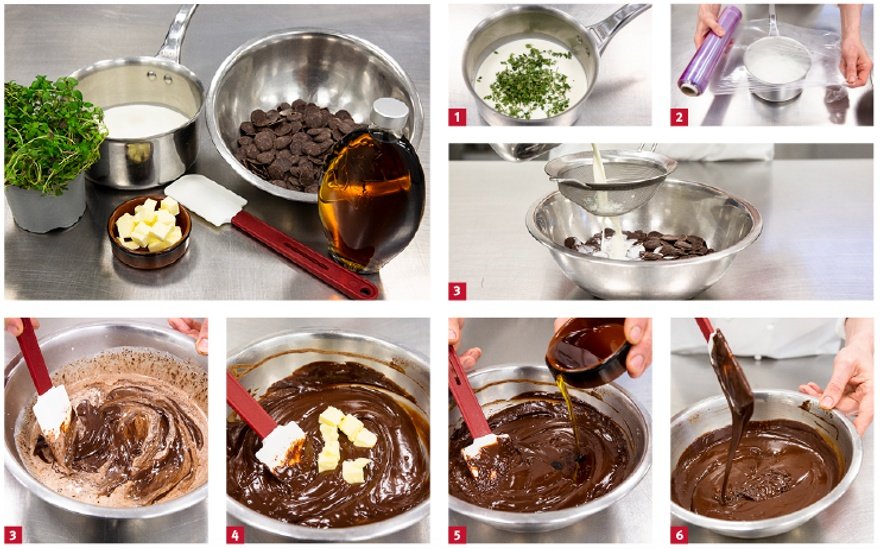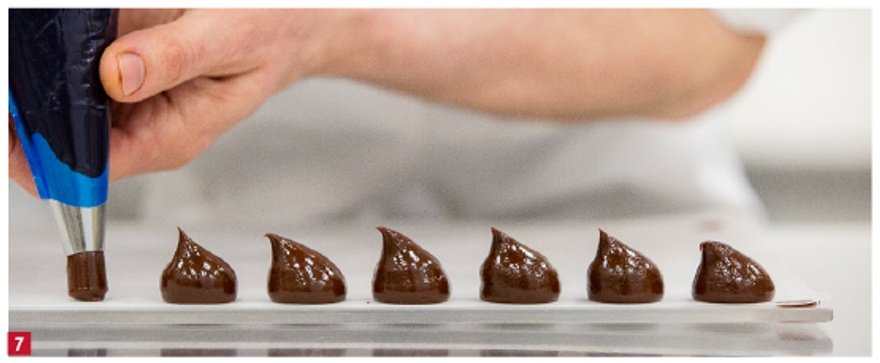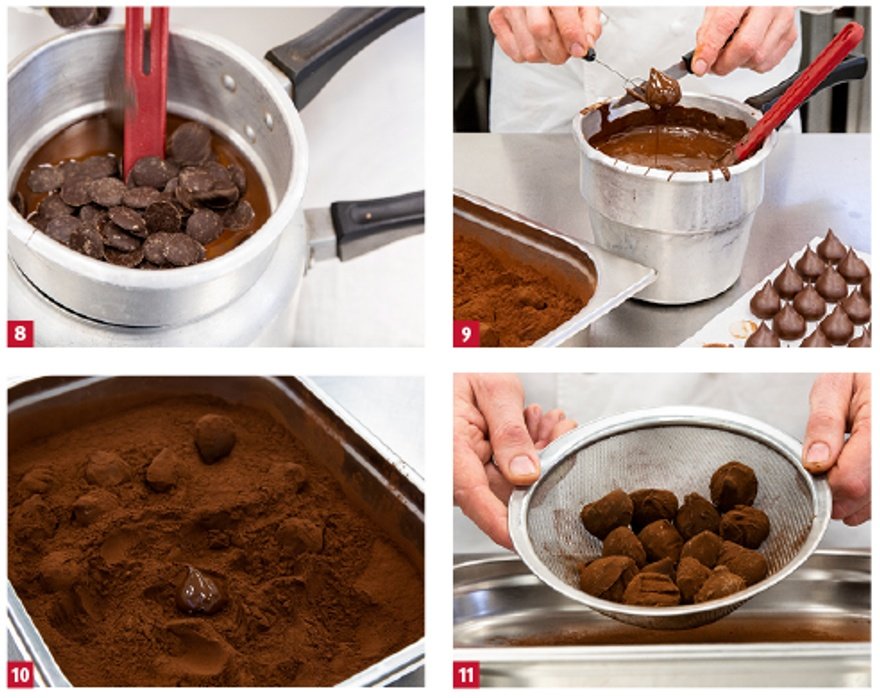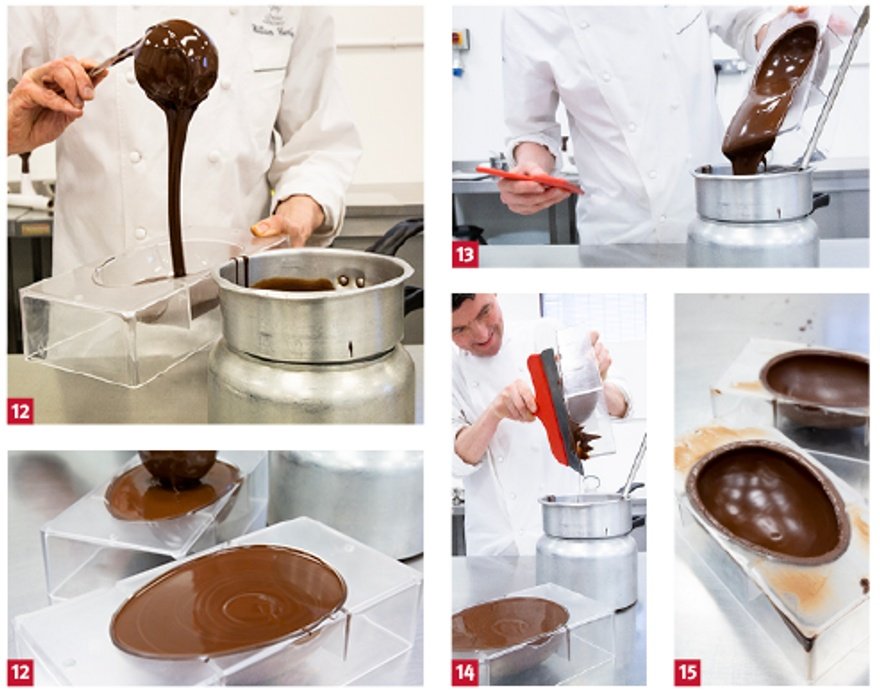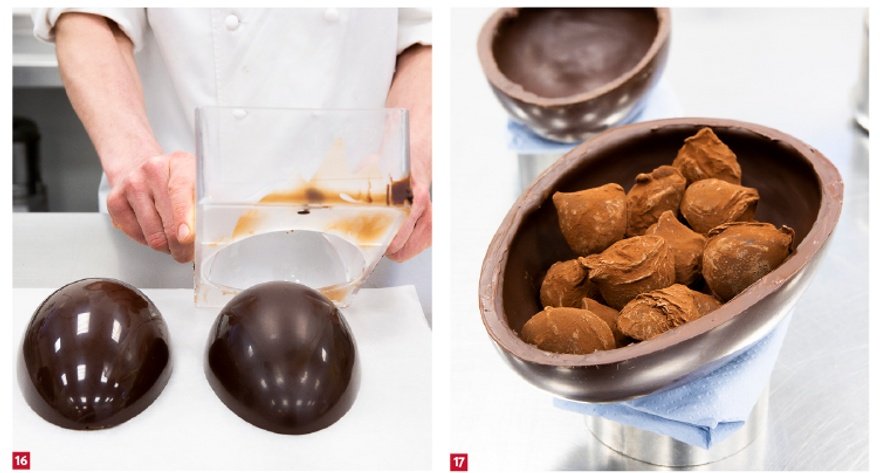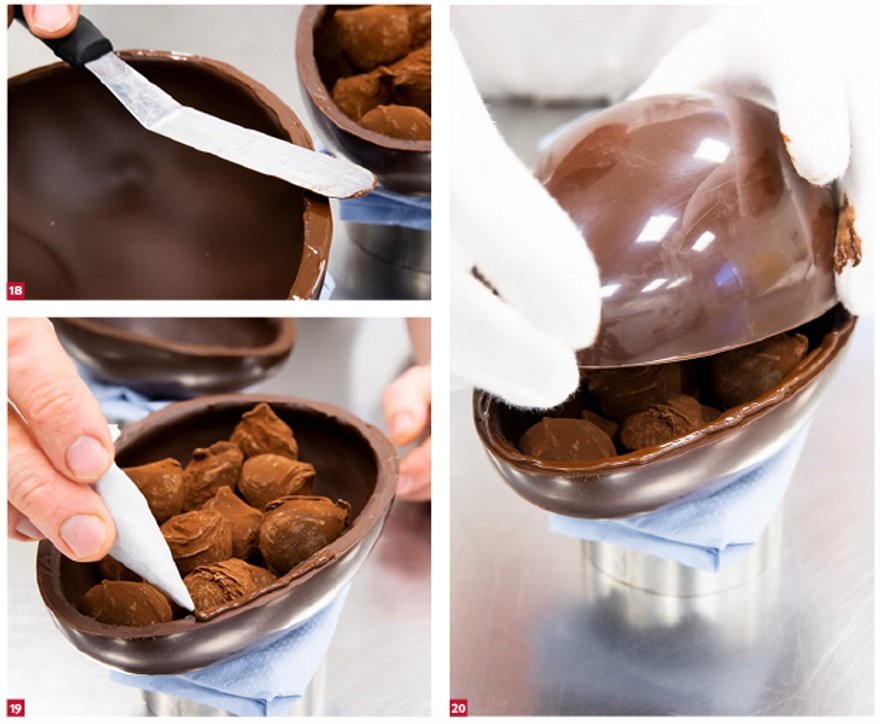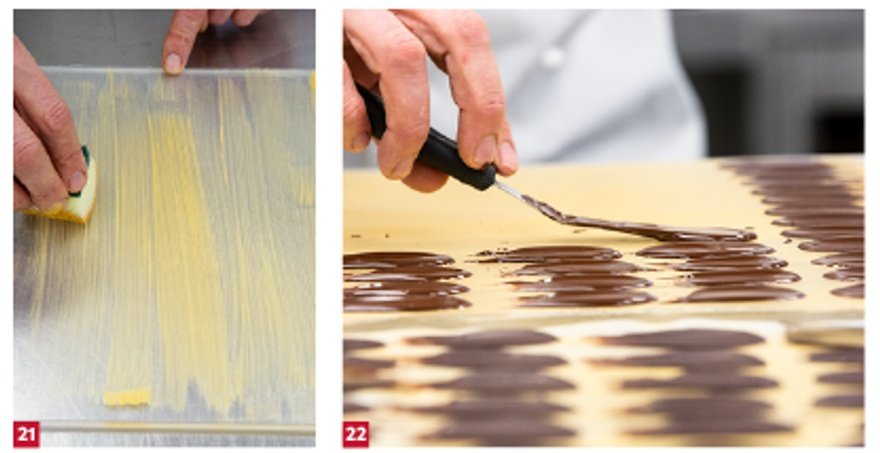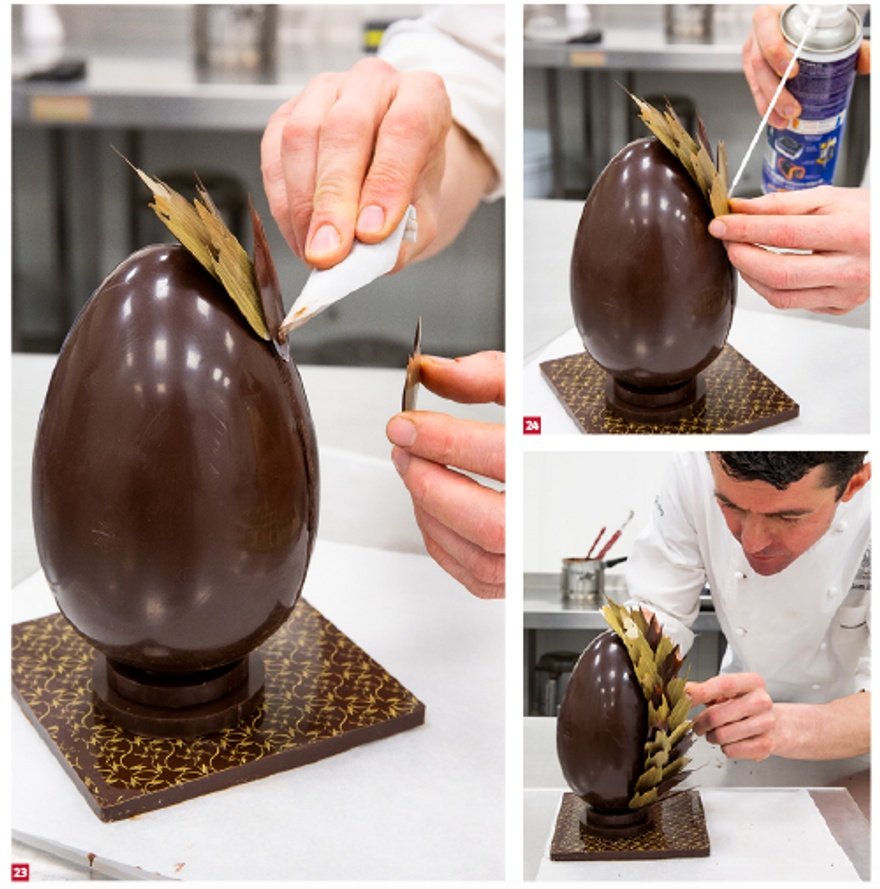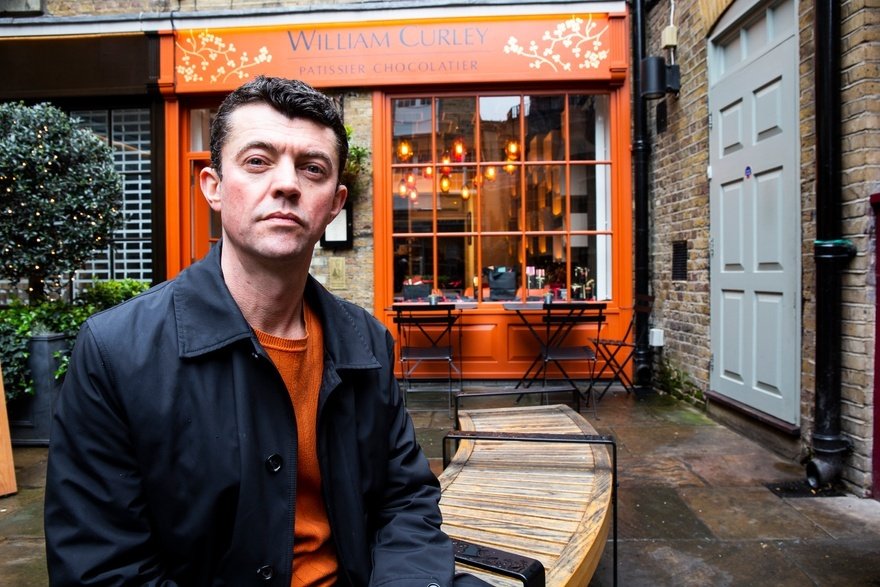William Curley celebrates Easter in style, with a truly extravagant creation stuffed with decadent maple syrup truffles. Michael Raffael reports
There are Easter eggs and there are hand-crafted artisan eggs. Cutting no corners, working with Amedei couverture, William Curley creates the chocolate equivalent of a Fabergé. It's as expensive (£60) as it is labour-intensive. The shelf-life is short – 14 days – but that's to be expected from a master chocolatier.
Tempering basics
Tempering adds snap and gloss to couverture. In a professional kitchen it's practical to work in multiples of 1kg batches. There are two classic ways to temper: one uses a chilled worktop or marble slab and the other, used by Curley, is the seeding method.
For a 1kg batch, place 660g of chopped couverture or pistils in a double-boiler or stand a pan over a bain-marie. The water should be hot but not boiling and it shouldn't touch the base of the pan. Keep stirring until the chocolate has melted. Use a thermometer to check that the temperature is between 45°C and 50°C.
Add the rest of the couverture bit by bit, stirring until it melts. It will cool as you stir. Continue to stir until the melted chocolate drops to 31°C or 32C°.
Note: Be very careful that no water or steam comes into contact with the melting chocolate.
Ganache basics
"The key to a good ganache is the quality of the ingredients" (Couture Chocolate by William Curley, published by Jacqui Small, 2011).
For 80 truffles
- 435ml whipping cream (36% fat)
- 60g invert sugar
- 500g dark couverture (minimum 66% cocoa solids), pistils or chopped small
- 75g unsalted butter
Bring the cream and invert sugar to the boil. Pour onto the couverture. Keep stirring until an emulsion forms. Add the butter at room temperature to obtain a smooth ganache. Cool, uncovered, until it's ready for piping – after one hour.
Thyme maple syrup truffles
Makes about 80 truffles. Note: recipe is based on the classic recipe with a few variations suited to the professional pâtisserie
- 380ml whipping cream
- 4g fresh thyme
- 300g couverture (70%) (Amedei)
- 100g milk chocolate couverture (35%)
- 50g dry butter
- 75g maple syrup
- For dipping, 1kg tempered couverture at 45°C-50°C
- Unsweetened cocoa powder (Cacao Barry Extra Brute)
Bring the whipping cream and thyme to simmering point (1). Leave the herb to infuse and then discard it (2).
Pour the cream onto the two chocolates and stir until the mixture is smooth (3). Add the butter (4) and emulsify it with the ganache and then mix in the maple syrup (5). Set aside for an hour (6).
Prepare a baking tray with silicone paper. Half-fill a piping bag fitted with a 12mm nozzle with ganache. Pipe truffles, about 8g each, onto the tray (7). Cool for 20 minutes in the fridge.
Prepare a double boiler with tempered couverture in it (8). Prepare a gastronorm container with cocoa powder. Prepare a second baking tray with silicone paper on it.
Using a dipping fork, dip each truffle in couverture (9) and then roll it in cocoa powder (10). Transfer to the prepared baking tray (11). Reserve until needed.
Note William Curley places 20 truffles into each chocolate egg.
William Curley's truffle-filled Easter egg
Makes one 18cm diameter egg
Equipment
Two 18cm Easter egg moulds, scraper, paper cornets for piping, baking sheet, acetone, hoop to stand egg on, cloth to prevent scratching, surgical gloves, refrigerant.
Egg
For each half-egg you'll need enough molten tempered couverture to fill the egg to overflowing (about 500g).
Check that the egg moulds are spotlessly clean. Fill one half to the brim (12), leave for about a minute and then empty the couverture back into the double-boiler or bowl (13). A film of chocolate about 2mm-3mm thick will stick to the mould. Repeat the process with the second egg. Scrape off surplus chocolate from the top of the mould (14).
Refrigerate the two chocolate shells so they harden. Scrape the top edges of the two shells so they are quite smooth (15).
Sealing
Put on gloves to prevent marking. Prepare a 100mm hoop with a clean cloth or kitchen paper on it.
Turn out the two set chocolate shells on the work surface (16). Stand one half on the hoop and fill with 20 truffles (17).
Flatten the surface of the rim with a hot palette knife (18). Pour a little melted couverture into a paper cornet and snip the end. Pipe some couverture around the rim of the chocolate shell (19) and fit the second chocolate shell on top. Leave to set (20).
Decoration
For the picture, Curley stood the finished egg on a chocolate socle or plinth, but any base is fine.
Lay an acetone sheet on a tray. Use a damp sponge to dab metallic food colouring on to the sheet (21), and spread it evenly with a paintbrush.
Using a small metal spatula, dip the end into melted chocolate and mark out splashes on top of the metallic paint (22). When set, these will form the chocolate shards used for decoration.
Use melted chocolate in a cornet to stick the shards on to the egg (23). Use the refrigerant spray to ensure each piece fixes immediately (24).
From cocoa beans to couverture
The three main kinds of cocoa beans – Criollo, Trinitario and Forastero – are well known. Traditionally, chocolatiers always plumped for Criollo, and Forastero was relegated to cheap and cheerful mass production. Trinitario used to be in the middle ground but is receiving more and more attention: Venezuelan Carenero and Rio Caribe in particular. Peruvian Nacional Forastero, recently identified as a new cultivar, also has a following.
Turning raw beans to couverture has several stages: fermentation, roasting, grinding and conching. Each one affects the final result. Conching describes the process where ground bean particles lose residual acidity and are blended with cocoa butter to obtain the desired texture and mouthfeel. The ratio of sugar to conched chocolate determines whether the result will be 60%, 70% or 80% couverture.
Some but not all couverture manufacturers add the emulsifier lecithin (soy or sunflower-based). The amount in high-quality couverture is 0.3%-0.4%. Using it decreases the amount of cocoa butter required. This isn't necessarily a bad thing, because the maker may, for instance, want to highlight the flavour of a single-origin chocolate.
Invert sugar
Chocolatiers prefer working with invert sugar: Trimoline, honey or maple syrup, when making truffles, depending on whether they want it to add flavour or not. In either event, it gives a smoother texture to the finished result.
For a basic version, boil 452g caster sugar, 350g water and a quarter teaspoon of citric/ascorbic acid to 114°C. Cool and store.
William Curley
Five years ago, William Curley severed links with his business partner, Sir Evelyn de Rothschild. The rift left Britain's best-known chocolatier out on a limb. At a stroke, the shops went and he found himself "semi-retired". Since then, he has, step by step, set about resurrecting himself.
The split, he admitted, wasn't overly acrimonious. "I wanted to retain my independence of how we did things and the route I wanted to go wasn't his. I love the pure, the natural; all the things that have guided me through my career." By implication, his partner had another vision for a larger brand.
Left only with his concession in Harrods and a string of catering partners he supplied, Curley set about resurrecting his career. "I was fortunate, because the first thing you need when you start a business is some money coming in. Some luxury hotels, Harrods and my online business were enough to get us back in the game."
Last Christmas he opened a boutique in Soho (33 Smith's Court) and he's moved his small laboratory from North Acton to Swan Island in the Thames. Both moves underline his determination to be his own man. The change has given him a second wind.
I don't want to draw attention to myself. It's the chocolates themselves that are the heroes, if you like
Even in a traditional craft like his, he said, it never pays to mark time. "I remember when I was working for Pierre Koffmann and he did a promo at Raffles hotel in Singapore. He came back with so many new ideas. He was at the pinnacle of his career, but he wanted to go up to the next level."
His relationship with hotel and restaurant clients is on an individual basis. For hotels like the Mandarin Oriental or Corinthia or the Ritz London, he works with a combination of flavours sold in his shop. "I don't want to draw attention to myself. It's the chocolates themselves that are the heroes, if you like."
He collaborates with chefs in a number of starred restaurants in the capital, creating bespoke bonbons and truffles. "I like working with them and they have plenty of ideas, but maybe not the time or the space to develop them."
For the past 12 years he has worked exclusively with Amedei. Along with Barry Callebaut and Valrhona, it's one of three main players that chocolatiers go to. As a company it too has changed from a small, family-run business into the subsidiary of Italian mineral water company Ferrarelle SpA.
"Yes," concedes Curley, "there are small companies producing fabulous chocolate, but I buy several tonnes a year and it makes the best bean to bar chocolate in the world. It just works for me. The way the flavour opens up when we do certain things with it makes it so special."
With a pedigree ranging from Tante Claire, Le Manoir and Marco Pierre White to a role as the Savoy's chef-pâtissier, Curley is conscious of changes to the world of pâtisserie and the need to evolve. Chocolate, he believes, is in a different position. It's more tied to a cultural tradition. Anyone who eats it wants to know what's in their mouth and savour it. "As a chef you're always looking for the next new thing, but chocolate is chocolate."
Continue reading
You need to be a premium member to view this. Subscribe from just 99p per week.
Already subscribed? Log In


